
Duck! Rabbit, Duck! is a 1953 Warner Bros. Merrie Melodies cartoon directed by Charles M. Jones. The cartoon was released on October 3, 1953 and stars Bugs Bunny, Daffy Duck and Elmer Fudd.

Ballot Box Bunny is a 1951 Warner Bros. Merrie Melodies theatrical cartoon short directed by Friz Freleng and written by Warren Foster. The cartoon was released on October 6, 1951, and features Bugs Bunny and Yosemite Sam.

Bugs Bunny and the Three Bears is a 1944 Merrie Melodies cartoon short directed by Chuck Jones and written by Tedd Pierce. The short was released on February 26, 1944, and features Bugs Bunny. This short marks the first appearance of Jones' dysfunctional version of The Three Bears, and is a parody of the old fairy tale, Goldilocks and The Three Bears.

Bunny Hugged is a 1951 Warner Bros. Merrie Melodies short, directed by Chuck Jones and written by Michael Maltese. The short was released on March 10, 1951, and stars Bugs Bunny. Bunny Hugged is essentially a re-working of Jones' 1948 short Rabbit Punch, substituting wrestling for boxing.

French Rarebit is a 1951 Warner Bros. Merrie Melodies animated short, directed by Robert McKimson and written by Tedd Pierce. Released June 30, 1951, the cartoon features Bugs Bunny. The title is a play on "Welsh rarebit", which is also known as "Welsh rabbit".
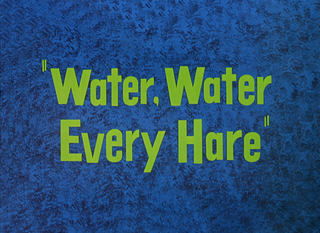
Water, Water Every Hare is a 1952 Warner Bros. Looney Tunes cartoon directed by Chuck Jones. The cartoon was released on April 19, 1952 and stars Bugs Bunny. The short is a return to the themes of the 1946 cartoon Hair-Raising Hare and brings the monster Gossamer back to the screen.

Wet Hare is a 1962 Warner Bros. Looney Tunes cartoon directed by Robert McKimson. The short was released on January 20, 1962, and stars Bugs Bunny. In the cartoon, Bugs finds himself at odds with a ruthless lumberjack who wants to control the water supply by building a series of dams.
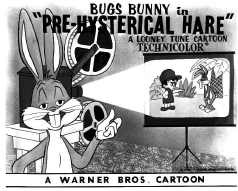
Pre-Hysterical Hare is a 1958 Warner Bros. Looney Tunes cartoon directed by Robert McKimson and written by Tedd Pierce. The short was released on November 1, 1958, and stars Bugs Bunny and Elmer Fudd. The two are in their usual hunter-and-bunny antics, but set in the Stone Age.

Haredevil Hare is a 1948 Looney Tunes cartoon directed by Chuck Jones. It stars Bugs Bunny and it is the debut for Marvin the Martian — although he is unnamed in this film—along with his Martian dog, K-9. Marvin's nasal voice for this first film is different from the later one he is most known for. This is also the last pre-August 1948 Looney Tunes and Merrie Melodies cartoon whose copyright was sold to Associated Artists Productions.
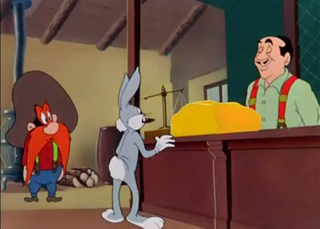
14 Carrot Rabbit is a 1952 Warner Bros. Looney Tunes animated cartoon short directed by Friz Freleng. The short was released on March 15, 1952, and features Bugs Bunny and Yosemite Sam. The title is a play on "14 karat", as in a purity level for gold.
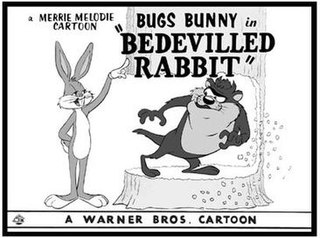
Bedevilled Rabbit is a 1957 Warner Bros. Merrie Melodies short directed by Robert McKimson. The short was released on April 13, 1957, and stars Bugs Bunny. In this cartoon, Bugs is lost in Tasmania, and has to deal with the Tasmanian Devil.
Hare-Way to the Stars is a 1958 American animated science fiction comedy short film directed by Chuck Jones and written by Michael Maltese. The short was released by Warner Bros. Pictures on March 29, 1958 as part of the Looney Tunes series, and stars Bugs Bunny and Marvin the Martian. The title is a play on the song "Stairway to the Stars."
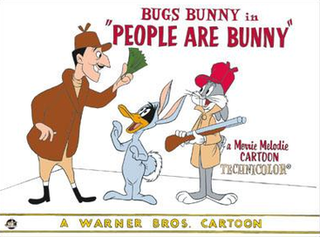
People Are Bunny is a 1959 Warner Bros. Merrie Melodies cartoon, directed by Robert McKimson The short was released on December 19, 1959, and stars Bugs Bunny and Daffy Duck.

To Hare is Human is a 1956 Warner Bros. Merrie Melodies cartoon directed by Chuck Jones. The short was released on December 15, 1956, and stars Bugs Bunny and Wile E. Coyote. In this film, Wile builds a UNIVAC computer, and grows to rely on its answers.
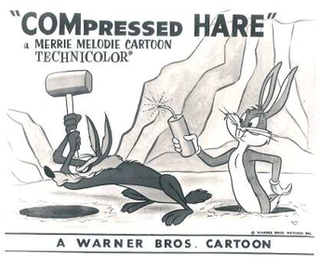
Compressed Hare is a 1961 Merrie Melodies cartoon directed by Chuck Jones and Maurice Noble. The short was released on July 29, 1961, and stars Bugs Bunny and Wile E. Coyote. This is the final first-run Golden Age short in which Wile E. Coyote speaks, although he speaks again in the Adventures of the Road Runner featurette a year later.

The Iceman Ducketh is a 1964 Warner Bros. Looney Tunes theatrical cartoon directed by Phil Monroe and Maurice Noble, with a story by John W. Dunn. The short was released on May 16, 1964, and stars Bugs Bunny and Daffy Duck. It was the penultimate Warner Bros. Theatrical Cartoon to feature Bugs Bunny and the last Warner Bros. theatrical cartoon to feature Bugs and Daffy together until Box-Office Bunny in 1991, and the last that the Chuck Jones unit worked on, though Chuck Jones himself was fired at an early stage of production and replaced by Monroe.
The Fair-Haired Hare is a 1951 Warner Bros. Looney Tunes cartoon starring Bugs Bunny and Yosemite Sam. Released April 14, 1951, the cartoon was directed by Friz Freleng. The voices were performed by Mel Blanc.

Now Hare This is a 1958 Warner Bros. Looney Tunes cartoon directed by Robert McKimson and written by Tedd Pierce. The short was released on May 31, 1958, and stars Bugs Bunny.
Hugo the Abominable Snowman is a character in the Looney Tunes franchise.















